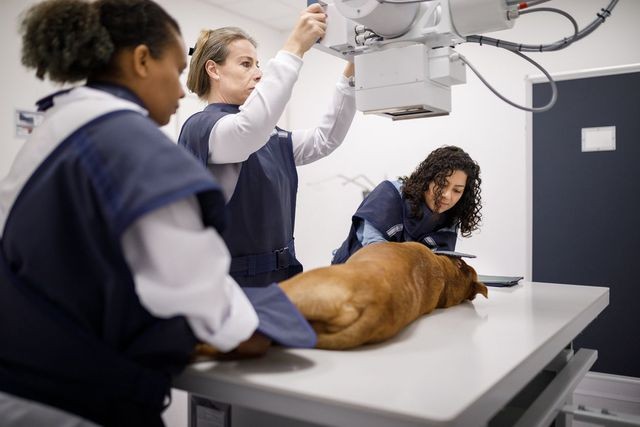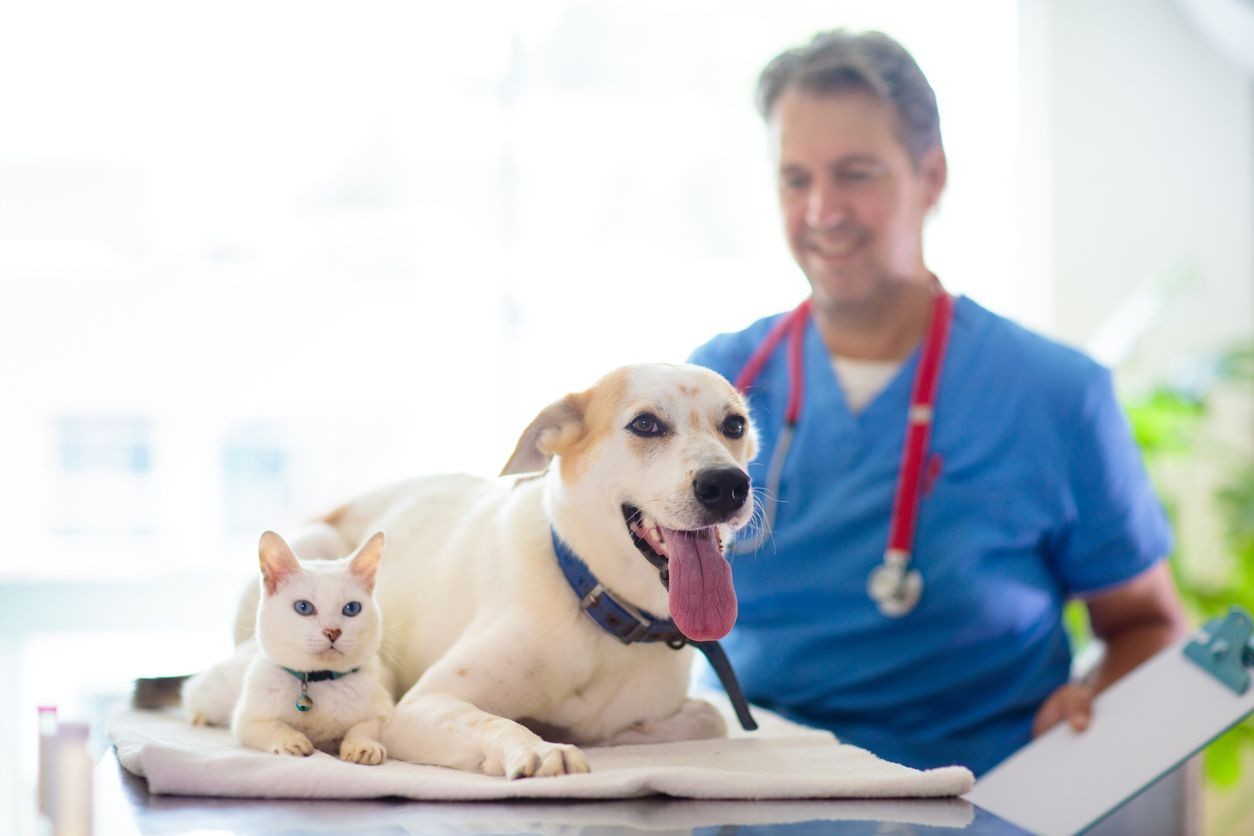Is your furry friend limping or showing signs of discomfort? An X-ray might be necessary to diagnose the problem. Understanding “How Much Do Pet X Rays Cost” is crucial for responsible pet ownership. At PETS.EDU.VN, we provide information to help you make informed decisions about your pet’s health and budget. Discover all you need to know about pet X-ray expenses, related factors, and ways to potentially save.
1. Understanding the Necessity of Pet X-Rays
X-rays, also known as radiographs, are non-invasive imaging techniques that use electromagnetic radiation to create visual representations of your pet’s internal structures. These images are invaluable diagnostic tools for veterinarians, helping them identify a wide range of conditions that might otherwise go unnoticed.
Here’s why X-rays are a crucial part of veterinary medicine:
- Diagnosing Skeletal Issues: X-rays are excellent for visualizing bones, making them ideal for detecting fractures, dislocations, arthritis, and other bone-related problems.
- Identifying Internal Issues: They can also help diagnose various internal conditions, such as heart enlargement, lung problems, tumors, and foreign objects.
- Dental Health: Intraoral X-rays provide detailed images of your pet’s teeth and jaw, allowing veterinarians to identify hidden dental problems like abscesses, impacted teeth, and bone loss.
- Emergency Situations: In emergency cases, X-rays can quickly reveal the extent of injuries, helping veterinarians make informed decisions about treatment.
X-rays are a versatile tool, but they’re not always the only option. Your vet will recommend the most appropriate diagnostic method based on your pet’s specific symptoms and medical history.
2. Situations Where Pet X-Rays Are Commonly Needed
There are numerous scenarios where your veterinarian might recommend an X-ray for your beloved pet. Some of the most common include:
- Lameness or Limping: If your pet is favoring a limb or showing signs of pain when walking, an X-ray can help identify fractures, dislocations, sprains, or arthritis.
- Trauma: After an accident, such as being hit by a car or falling from a height, X-rays can reveal broken bones, internal injuries, or foreign objects.
- Breathing Difficulties: If your pet is coughing, wheezing, or having trouble breathing, an X-ray can help diagnose lung conditions like pneumonia, bronchitis, or tumors.
- Abdominal Issues: For pets experiencing vomiting, diarrhea, or abdominal pain, X-rays can help identify intestinal blockages, foreign objects, or organ enlargement.
- Dental Problems: If your pet has bad breath, bleeding gums, or difficulty eating, dental X-rays can reveal hidden dental issues that require treatment.
2.1 Case Study: Diagnosing Hip Dysplasia with X-Rays
Hip dysplasia, a common skeletal condition especially in larger dog breeds, is often diagnosed using X-rays. The images allow veterinarians to assess the structure of the hip joint and look for signs of degeneration.
3. Limitations of X-Rays: When They Aren’t Enough
While X-rays are incredibly useful, they have limitations. They are best at visualizing bones and dense tissues but are less effective for examining soft tissues. Here are some situations where X-rays might not be the best diagnostic tool:
- Soft Tissue Injuries: For muscle strains, ligament tears, or other soft tissue injuries, other imaging techniques like ultrasound or MRI might provide more detailed information.
- Neurological Conditions: While X-rays can sometimes reveal spinal problems, MRI is often needed to diagnose conditions affecting the brain or spinal cord.
- Pancreatitis: Diagnosing pancreatitis typically requires blood tests and ultrasound, as X-rays are not very effective at visualizing the pancreas.
- Early-Stage Tumors: Small or early-stage tumors might not be visible on X-rays, requiring more sensitive imaging techniques like CT scans or MRIs.
Remember, your veterinarian will choose the most appropriate diagnostic tool based on your pet’s individual needs and symptoms.
4. Factors Influencing the Cost of Pet X-Rays
Many factors can influence how much you’ll pay for a pet X-ray. Understanding these factors can help you prepare for the expense and potentially find ways to save money.
4.1 Size of Your Pet
Larger animals generally require larger X-ray plates and more radiation to get a clear image. This translates to higher costs for the clinic, which are often passed on to the pet owner. Additionally, larger pets may require more personnel to safely handle and position them during the procedure.
Typical Cost Variation Based on Size:
| Pet Size | Estimated Cost Range |
|---|---|
| Small Cat/Dog | $75 – $150 |
| Medium Dog | $150 – $300 |
| Large Dog | $250 – $500 |


4.2 Number of X-Ray Views Needed
A single X-ray image provides only one perspective. Veterinarians often need multiple views from different angles to get a complete picture of the area in question. Each additional view increases the cost.
Why Multiple Views Are Important:
- Improved Accuracy: Multiple views help ensure that no hidden fractures, dislocations, or other abnormalities are missed.
- Better Localization: Different angles help the vet pinpoint the exact location of a problem.
- 3D Understanding: Combining multiple 2D images helps the vet visualize the problem in three dimensions.
4.3 Sedation or Anesthesia Requirements
Some pets, especially those in pain or who are anxious, may need sedation or anesthesia to stay still during the X-ray. This ensures clear images and minimizes stress for the animal. Sedation and anesthesia add to the overall cost, as they require additional monitoring and medication.
Considerations for Sedation/Anesthesia:
- Cost: Sedation typically costs less than general anesthesia.
- Risk: Both sedation and anesthesia carry some risk, especially for older or sick animals.
- Recovery: Recovery from sedation is generally faster than recovery from anesthesia.
4.4 Location and Type of Veterinary Clinic
Veterinary costs vary significantly depending on your location. Clinics in urban areas or those with higher costs of living tend to charge more. Additionally, emergency clinics and specialty hospitals typically have higher fees than general practice clinics.
Types of Veterinary Clinics and Their Cost Implications:
| Clinic Type | Cost Level | Pros | Cons |
|---|---|---|---|
| General Practice | Moderate | Convenient, familiar vet | May not have advanced equipment or specialists |
| Emergency Clinic | High | Open 24/7, handles urgent cases | Higher fees, may not be your regular vet |
| Specialty Hospital | Very High | Advanced equipment, specialists available | Most expensive, requires referral from general vet |
| Charity Clinic | Low | Affordable care, often donation-based | Limited services, may have long wait times |
4.5 Additional Services
Before the X-ray, your vet might recommend blood tests or IV fluids. These services can add to the overall cost, but they’re sometimes necessary to ensure your pet’s safety and provide the best possible care.
Examples of Additional Services and Their Purposes:
- Pre-X-Ray Blood Test: Checks for underlying health issues that could affect sedation or anesthesia.
- IV Fluids: Help maintain blood pressure and hydration during sedation or anesthesia.
- Pain Medication: Can help keep your pet comfortable before, during, and after the procedure.
4.6 Specialized X-Rays
Certain X-rays, like those required for elbow or hip scoring in breeding dogs, demand precise techniques and detailed assessment, incurring extra charges.
5. Cost Comparison: X-Rays vs. Other Imaging Techniques
X-rays are often the first-line imaging technique due to their affordability and availability. However, depending on the situation, other imaging options might be more appropriate. Here’s a cost comparison of common veterinary imaging techniques:
| Imaging Technique | Typical Cost Range | Best For |
|---|---|---|
| X-Ray | $75 – $500 | Bones, foreign objects, some internal organ issues |
| Ultrasound | $300 – $600 | Soft tissues, abdominal organs, heart |
| CT Scan | $1,000 – $2,500 | Detailed imaging of bones, soft tissues, and blood vessels |
| MRI | $2,500 – $5,000 | Brain, spinal cord, soft tissues, ligaments, tendons |
As you can see, X-rays are generally the most affordable option, but they might not always provide the level of detail needed for a diagnosis.
6. Real-World Cost Examples
To give you a better sense of the actual costs, here are some real-world examples of pet X-ray expenses:
6.1 Example 1: Simple Fracture Diagnosis
- Pet: Small dog with a suspected broken leg
- Services: X-ray (2 views), pain medication
- Total Cost: $250
6.2 Example 2: Emergency Foreign Body
- Pet: Cat who ingested a foreign object
- Services: X-ray (3 views), sedation, emergency exam fee
- Total Cost: $600
6.3 Example 3: Hip Dysplasia Screening
- Pet: Large dog undergoing hip dysplasia screening
- Services: X-ray (specialized views), sedation, veterinarian consultation
- Total Cost: $750
These examples are just estimates, and the actual cost can vary depending on the factors mentioned earlier.
7. Strategies for Lowering Pet X-Ray Costs
While you can’t always predict when your pet will need an X-ray, there are steps you can take to potentially lower the costs:
- Pet Insurance: Pet insurance can help cover the cost of unexpected veterinary care, including X-rays.
- Preventative Care: Keeping your pet healthy with regular checkups, vaccinations, and parasite prevention can help reduce the risk of injuries and illnesses that might require X-rays.
- Shop Around: Call different veterinary clinics to compare prices before scheduling an X-ray.
- Discuss Options with Your Vet: Ask your vet about the necessity of additional services and whether there are any lower-cost alternatives.
- Consider a Payment Plan: Some clinics offer payment plans to help you spread out the cost of veterinary care.
- Charity and Non-Profit Organizations: Explore financial aid options from animal welfare organizations if you qualify.
7.1 Trauma and Injury Prevention
Keeping your dog leashed outdoors, keeping your cat indoors, and neutering outdoor cats reduces the risk of accidents, lowering the need for emergency X-rays.
8. The Importance of Choosing the Right Veterinary Clinic
Selecting a reputable veterinary clinic is crucial for ensuring your pet receives high-quality care at a fair price. Look for a clinic with experienced veterinarians, state-of-the-art equipment, and a commitment to patient comfort and safety.
Factors to Consider When Choosing a Veterinary Clinic:
- Qualifications and Experience: Make sure the veterinarians are licensed and experienced in interpreting X-rays.
- Equipment: The clinic should have modern X-ray equipment that produces high-quality images.
- Reputation: Read online reviews and ask for recommendations from friends and family.
- Communication: The veterinarians and staff should be able to clearly explain the procedure and answer your questions.
- Cost: While cost shouldn’t be the only factor, it’s important to find a clinic that offers fair and transparent pricing.
9. When Is Sedation Necessary for Pet X-Rays?
Sedation might be necessary if your pet is anxious, in pain, or unable to stay still during the X-ray. While it adds to the cost, it ensures clearer images and minimizes stress for your pet. Discuss the pros and cons of sedation with your vet to make an informed decision.
10. Navigating Pet X-Ray Costs with PETS.EDU.VN
At PETS.EDU.VN, we understand that pet care costs can be a concern for many owners. That’s why we’re committed to providing you with valuable information and resources to help you make informed decisions about your pet’s health and budget.
10.1 Expert Advice and Information
We offer a wide range of articles and guides on pet health, wellness, and preventative care, helping you stay informed and proactive about your pet’s needs.
10.2 Local Pet Care Services
Our directory of local pet care services can help you find reputable veterinary clinics, emergency hospitals, and other pet-related businesses in your area.
10.3 Cost-Saving Tips and Resources
We provide tips and resources on saving money on pet care, including information on pet insurance, payment plans, and financial aid options.
We believe that every pet deserves access to quality care, regardless of their owner’s financial situation. Let PETS.EDU.VN be your trusted partner in navigating the world of pet ownership and ensuring your furry friend lives a long, healthy, and happy life.
11. Understanding Your Pet Insurance Options
Pet insurance can be a lifesaver when unexpected veterinary expenses arise. Different policies offer varying levels of coverage, so it’s important to understand your options before enrolling.
11.1 Types of Pet Insurance Plans
- Accident-Only: Covers costs related to accidents, such as broken bones, cuts, and foreign object ingestion.
- Accident and Illness: Covers both accidents and illnesses, including infections, allergies, and chronic conditions.
- Comprehensive: Offers the most extensive coverage, including accidents, illnesses, preventative care, and sometimes even dental care.
11.2 Factors Affecting Pet Insurance Premiums
- Pet’s Age: Older pets typically have higher premiums due to their increased risk of health problems.
- Pet’s Breed: Certain breeds are predisposed to specific health conditions, which can affect insurance costs.
- Coverage Level: Higher coverage levels and lower deductibles will result in higher premiums.
- Location: Veterinary costs vary by location, so insurance premiums may also vary.
11.3 Pre-Existing Conditions
Most pet insurance policies do not cover pre-existing conditions. This means that if your pet has a health issue before you enroll in insurance, the policy won’t cover treatment for that condition.
12. The Future of Veterinary Imaging
Veterinary imaging is constantly evolving, with new technologies and techniques emerging all the time. These advancements are leading to more accurate diagnoses, less invasive procedures, and improved outcomes for pets.
12.1 Advancements in Digital Radiography
Digital radiography offers several advantages over traditional film-based X-rays, including faster image acquisition, better image quality, and the ability to manipulate images digitally.
12.2 The Role of Artificial Intelligence
Artificial intelligence is being used to develop tools that can assist veterinarians in interpreting X-rays and other imaging studies. These tools can help identify subtle abnormalities that might be missed by the human eye.
12.3 Telemedicine and Remote Imaging
Telemedicine is making it easier for pet owners to access veterinary care from the comfort of their homes. Remote imaging allows veterinarians to review X-rays and other images remotely, providing faster and more convenient diagnoses.
13. FAQ: Frequently Asked Questions About Pet X-Rays
13.1 How long does a pet X-ray take?
The actual X-ray procedure usually takes only a few minutes. However, the entire appointment, including preparation and consultation, can take 30-60 minutes.
13.2 Is radiation exposure a concern for my pet?
The amount of radiation used in pet X-rays is generally considered safe. Veterinarians take precautions to minimize radiation exposure to both pets and staff.
13.3 Can I be present during my pet’s X-ray?
In most cases, you will not be allowed to stay in the room during the X-ray to minimize your own radiation exposure.
13.4 How quickly will I get the results of the X-ray?
In most cases, your veterinarian will be able to review the X-ray images and discuss the results with you immediately after the procedure.
13.5 What if the X-ray doesn’t provide a clear diagnosis?
If the X-ray is inconclusive, your veterinarian might recommend additional imaging techniques like ultrasound, CT scan, or MRI.
13.6 Can X-rays detect cancer in pets?
X-rays can sometimes detect tumors or other signs of cancer, but they are not always the most reliable diagnostic tool for cancer.
13.7 Are there any alternatives to X-rays for diagnosing pet health issues?
Depending on the situation, ultrasound, CT scan, MRI, or blood tests might be used as alternatives to X-rays.
13.8 How should I prepare my pet for an X-ray appointment?
Follow your veterinarian’s instructions regarding food and water restrictions. Also, try to keep your pet calm and relaxed before the appointment.
13.9 Will my pet need a follow-up appointment after the X-ray?
Your veterinarian will determine whether a follow-up appointment is necessary based on the X-ray results and your pet’s condition.
13.10 Is it possible to get a discount on pet X-rays?
Ask your vet about potential discounts, especially if you’re a senior citizen, student, or member of the military. Some clinics also offer package deals or wellness plans that can reduce the cost of X-rays and other services.
14. Conclusion: Prioritizing Your Pet’s Health
Understanding the costs associated with pet X-rays is an essential part of responsible pet ownership. At PETS.EDU.VN, we are dedicated to providing you with the knowledge and resources you need to make informed decisions about your pet’s health.
Remember, your pet’s well-being is the top priority. Don’t hesitate to seek veterinary care when needed, and explore the options available to make it more affordable.
Address: 789 Paw Lane, Petville, CA 91234, United States
Whatsapp: +1 555-987-6543
Website: PETS.EDU.VN
By staying informed and proactive, you can ensure your furry friend receives the best possible care and lives a long, healthy, and happy life. We encourage you to explore pets.edu.vn for more in-depth articles, guides, and resources on pet health and wellness. Your pet deserves the best, and we’re here to help you provide it.

